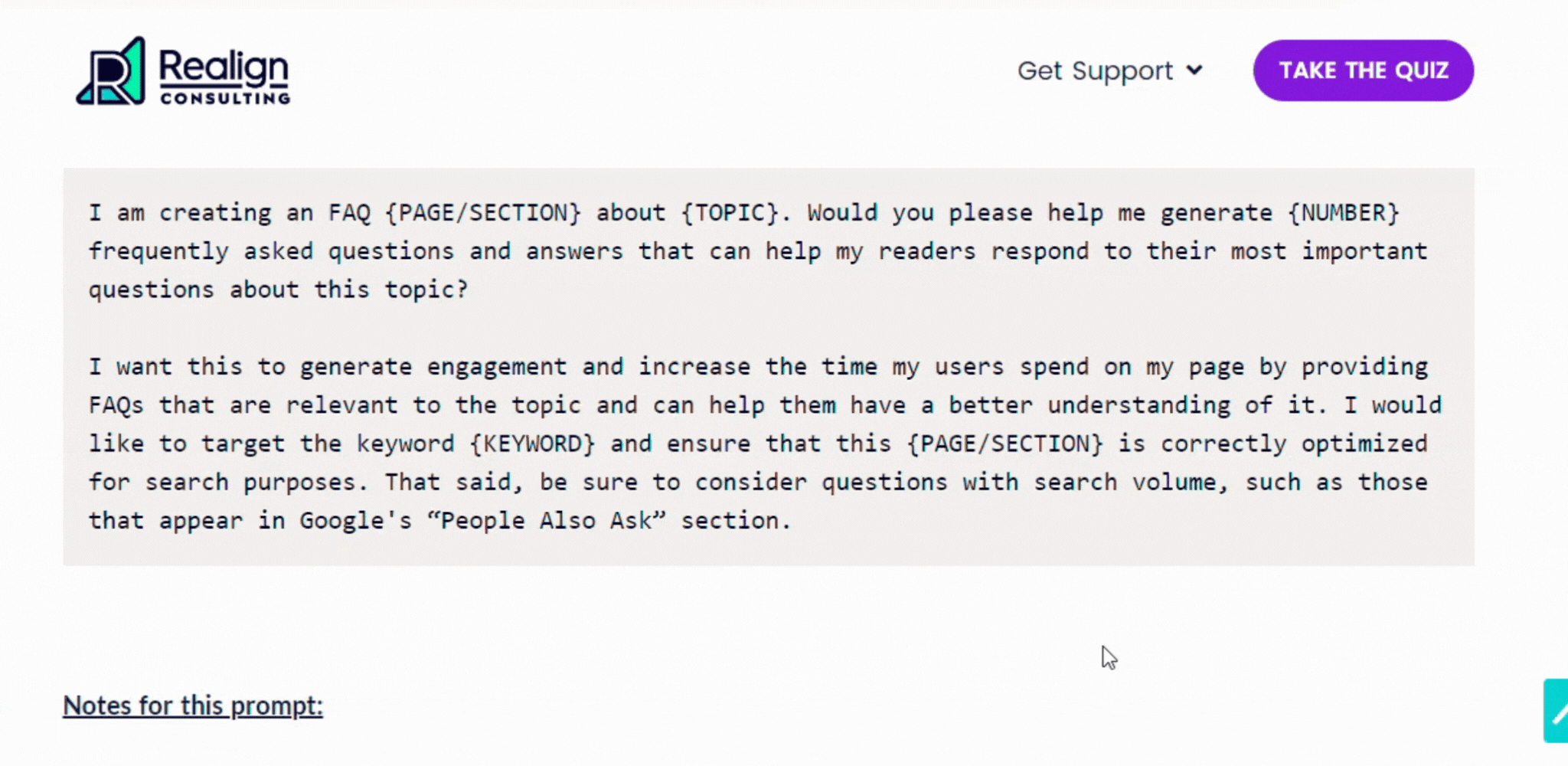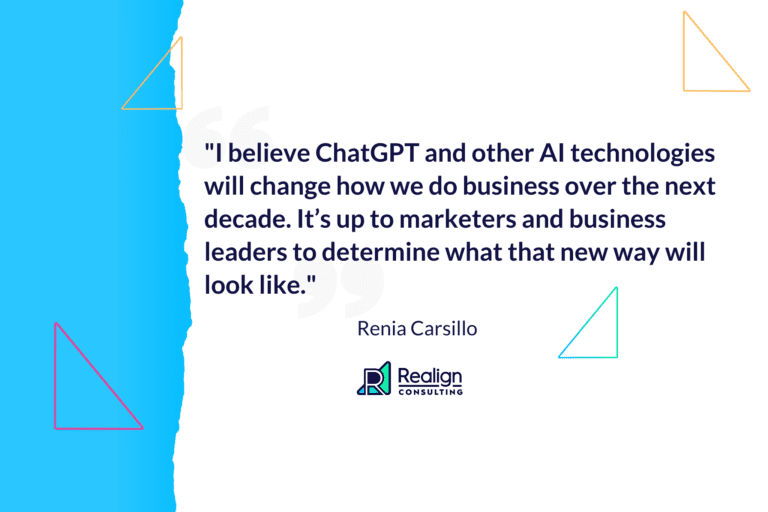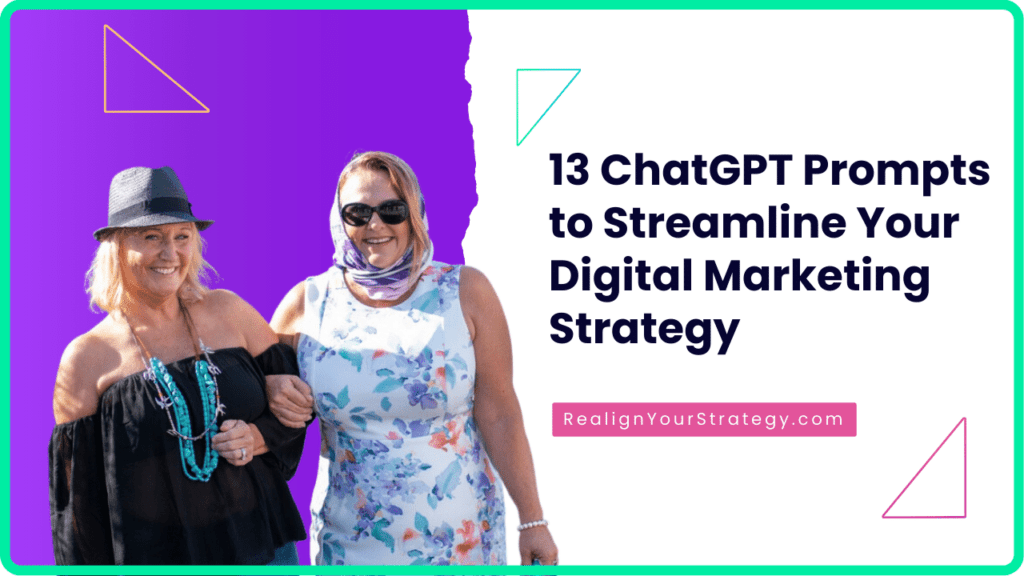We’re not big fans of trends, but this one isn’t likely to stay a trend for long. And, right now, you can try it for free.
Open AI’s much-publicized ChatGPT is worth experimenting with, especially with the right prompts to save you time with your digital marketing strategy.
The most important part of your digital marketing strategy is your words. As a generator of words, ChatGPT can help streamline your marketing process.
ChatGPT is a type of large language model, meaning it was trained on large amounts of text from the internet to be able to generate natural-sounding responses. It also continues to train on what users worldwide put into it.
At Realign Consulting, we advise most small and micro businesses to use a copy-first marketing strategy. (Copy is the name for writing designed to persuade or sell.)
So, our team has been working to determine the best ways for founders and their teams to use ChatGPT for their marketing processes and bring greater value to their customers faster.

From our experimentation, we’ve developed 13 ChatGPT prompts for digital marketing that our readers can use right away.
When it comes to DIY digital marketing, you need tools that save you time without sacrificing quality and effectiveness. Use these ChatGPT prompts to…
(Click the links below to go directly to that prompt)
- Help you populate your Google Business Profile for better local search visibility
- Generate an SEO title and meta description for your web pages (the sentence or two that shows up under the blue link on search results pages)
- Generate a list of possible content ideas to help you populate your blog
- Create an outline and SEO Content Brief to help organize your thoughts when writing an article or creating a video
- Draft a blog article that follows your specifications and best SEO practices
- Create a list of possible CTAs (calls to action) for a landing page or ad
- Optimize your headlines or email subject lines for better click-through-rates
- Draft a social media post tailored to a specific platform
- Draft a press release about company news relevant to your community
- Draft descriptions of a product or service you are offering
- Generate automated email or chatbot replies to make that setup easier
- Start a list of basic questions for a poll or survey to help with audience research
- Produce questions for an FAQ page, especially for a new product or service
The key to using ChatGPT is creating suitable prompts to generate useful output. You generally get out what you put in.

Once you get the hang of using it, ChatGPT can be fun to experiment with. You may be surprised at how well it can help you increase efficiency so you can focus more resources on what brings you joy.
Getting started with ChatGPT is easy. You simply go to chat.openai.com, create an account, and chat with the bot.
But getting quality output from ChatGPT is another matter entirely.
Learning to get useful output takes a little finesse because you must ensure the machine understands the assignment.
When you ask ChatGPT to generate something for you or answer a question, you are using a prompt.
That prompt can be basic, such as “What are some frequently asked questions people ask before hiring a cleaning service?”
When I prompted ChatGPT with this question, it generated these sample FAQs:
FAQ 1: Are your cleaning services licensed and insured?
FAQ 2: What types of cleaning services do you offer?
FAQ 3: Do I need to provide cleaning supplies and equipment?
FAQ 4: How do you ensure the security and privacy of your home?
FAQ 5: How do you determine the cost of your cleaning services?
It also generated answers to these questions that could be revised with the specifics of the particular service.
This is a great start. But you can also use a more complex prompt for a customized response.
For example, I then used this prompt:
I am creating an FAQ section for a home cleaning service I provide. Please generate 5 frequently asked questions and answers that can help my readers respond to their most important questions about this topic.
I want this section to generate engagement and increase the time my users spend on my page by providing FAQs that are relevant to the topic and can help them have a better understanding of it. I would like to target the keyword “home cleaning service” and ensure this section is properly optimized for search purposes. That said, consider questions with search volume, such as those that appear in Google's “People Also Ask” section.
From this prompt, ChatGPT generated the five questions below. Notice that they are all different from the first set of questions, with one exception:
FAQ 1: What services does your home cleaning service offer?
FAQ 2: How do you ensure the quality and consistency of your home cleaning service?
FAQ 3: Are your home cleaning services customizable based on my specific requirements?
FAQ 4: How do I schedule a home cleaning service with your company?
FAQ 5: Are your home cleaning services safe for my family and pets?
This second set of questions is slightly more personalized, and if I were creating this page for an actual client, I would consider using all ten questions or ensuring that I answered a few of them in the sales page copy.
- While simple prompts can be helpful, more complex prompts can generate content more closely tailored to your goals.
There are a few things to remember when creating personalized ChatGPT prompts for digital marketing.
These are some things our team keeps in mind when creating a prompt:
Ask yourself: What does ChatGPT need to understand about my company to create output that makes sense for my brand?
And always revise its response to ensure the final product matches your brand voice, accurately reflects your values, is relevant to your specific audience, and contains accurate details.
Creating detailed prompts can be time-consuming, so we’ve done some of the work for you.
Below, you’ll find 13 ChatGPT prompts for digital marketing to help you begin streamlining your marketing tasks to create compelling and engaging content.
Start experimenting with 13 easy ChatGPT prompts for digital marketing.
Our team tested each of these prompts to optimize them for you.
As demonstrated above, a more detailed prompt generates a more specific answer. You may find that these prompts are more complex than those you will find elsewhere because we want your results to be as close as possible to what you need for your business.

Once you’ve decided to use a prompt, hover your mouse over the top right corner of the prompt.
The word “Copy” will appear, and one click will add the prompt to your clipboard, ready to paste into ChatGPT.
Also, please note that words surrounded by brackets indicate that you must input specific information. We have added definitions and additional resources after each prompt as needed.
-
Optimize your Google Business Profile for better visibility.
Google’s free tool, Google My Business, is a must-have for businesses who want to rank for local search. Now called Google Business Profile, this tool lets companies manage how they appear in Google search results, making it easier for local customers to engage with their brand.
ChatGPT knows the tools by its former name (Google My Business), but the general optimization advice hasn’t changed.
Use the prompt below to get some ideas on how to make the most of your online profile:
I am optimizing my business in Google My Business to follow the best local SEO practices. The name of my company is {COMPANY NAME}, and we are based in {CITY/AREA, STATE, COUNTRY}. My business offers {INPUT YOUR PRODUCTS, SERVICES AND/OR BUSINESS MODEL}, and our values focus on {VALUES}. The main goal of this company is to {GOAL}, and I would like to reflect these things in a profile.
Would you please provide the following for my GMB account:
- Business Category: Suggest the most appropriate one based on the provided information.
- Description: Please create a template that can describe my business while ensuring high visibility in my industry
- Services: Please list the most appropriate services available in GMB that match my business.
Notes for this prompt:
- It is essential to include as many details as possible about your business for better results. Consider what you like knowing about a business when you’re looking for a restaurant/mechanic/plumber near you.
- Use the above as a baseline to start setting up your GMB profile, and avoid pasting the output directly into your profile without proper analysis.
-
Generate H1s, Title Tags, and Meta Descriptions to Help Boost Your Website SEO.
Our web pages’ metadata and main titles significantly influence visibility. They are usually the first things visitors see to determine if they want to visit your site. Search engine bots also use this information to help determine where to rank your page in search results.
Click here to learn more about metadata
Try using this ChatGPT prompt next time you are creating metadata and titles:
I’m writing about {TOPIC}, and I want to create strong metadata that can reflect the content on the page, satisfy the user intent for my target keyword, and follow the SEO-best practices so my page can rank well on Google based on the top-ranking pages for this term. My target keyword is {KEYWORD}, and its search intent is {INFORMATIONAL/COMMERCIAL/NAVIGATIONAL/TRANSACTIONAL}.
Please generate an H1 for my page, a title tag between 50 and 60 characters, and a meta description between 70 and 160 characters. Be sure to include my keyword in each of these, ideally on an exact-match basis, but broad-match is also acceptable.
My brand focuses on {NAME 2-5 PRODUCTS/SERVICES AND VALUES OF YOUR BRAND}, so keep that in mind when you write the metadata.
Notes about this prompt:
- Your search intent is the most likely motivator for someone to click on your page. If you have more than one search intent, include both in your prompt.
- Informational means they are looking for an answer to a question or more information about a particular topic. Examples include “Benefits of yoga” or How to bake a cake.”
- Commercial means they are looking at options before making a purchase. Examples include “Top-rated electricians near me” or “Best iPad case under $20.”
- Navigational means they are looking for a specific website or page. Examples include “Sally’s Nail Spa address” or “Frank’s Plumbing phone number.
Transactional means they are ready to make a purchase or take some other specific action. Examples include “Get a quote for drywall repair” or “Book car inspection appointment.”
- If you’re not sure how to determine the target keyword for each of your pages, check out this guide from Ahrefs.
- Be sure to generate a few different options so that you have plenty of ideas to work with. As always, be ready to revise the results to check for accuracy and match your brand voice.
-
Generate blog content topics about a specific industry, topic, product, or service.
Video and written blogs can be beneficial for cultivating a relationship with your audience. However, constantly coming up with new ideas can get old fast.
Mix things up by using ChatGPT to generate some of those ideas. You never know what will spark an idea of your own!
Imagine you’re an expert marketer with a solid background in SEO, especially for content planning and content management.
I would like to produce content pieces for {INDUSTRY/TOPIC/PRODUCT/SERVICES}, and I need to find {BLOG/VIDEO} content ideas that target relevant keywords for the said purpose. By creating this content, I mean to {SPECIFY 1-3 GOALS}.
Can you help me generate {NUMBER} content ideas that are optimal for the above criteria and follow the best practices to achieve my goals?
Notes about this prompt:
We recommend defining up to three services, products, or topics but only one industry. This helps the AI system keep the focus on your content type and link it to your objectives.
If you’ve done the work to determine the personas of your target audience, provide that information in the prompt as well for a more customized result. Audience personas can help clarify your content marketing strategy. (Learn more about personas here.)
Be clear about your goals for the blog posts you are looking to write. Use this prompt as many times as you need to generate different results based on different goals.
Some examples of clear goals include…
- “Increase the social traffic to my website and create more organic engagement in my audience.”
- “Raise awareness about the importance of ethical marketing in today’s world.”
-
Generate an SEO content brief that outlines a blog article.
Once you’ve chosen a topic to start writing about, it’s time to face the blank page.
Fortunately, ChatGPT can get you past that hurdle with an SEO-optimized outline to get you started. You’ll want to double-check ChatGPT’s output to ensure it aligns with optimization best practices, so be sure to check out our content optimization strategies here.
Try this prompt next time you’re creating new content that you want to give the best possible chances of ranking well and drawing in more traffic.
Please help me create an SEO content brief for my next blog article. This article will cover the following topic: {TOPIC}. The target keyphrase I’d like to have for this page is {KEYWORD}. After some research, I’ve noticed that the searches for this keyword have an {INFORMATIONAL/COMMERCIAL/NAVIGATIONAL/TRANSACTIONAL} intent.
I have an expert copywriter who can create the content, but that person could use the help of an optimized outline that follows the best SEO practices so the article can rank well on Google. I would also like to include the most important sections covered by top-ranking competitors without losing the unique selling points of my business and our own branding and expertise. The services and values that differentiate my business are {NAME 3-5 PRODUCTS/SERVICES AND VALUES UNIQUE TO YOUR BRAND}.
The output should contain the following:
1. All the necessary sections with proper HTML markup so the content is well-structured and has good readability, i.e., please include heading types and other elements
2. Recommended word counts for each section, along with a short description of what the writer is supposed to explain
3. Recommended word count for the whole article
4. Strategic notes about the way to approach the copy based on the target keyword and its search intent
Notes about this prompt:
- Before you use this prompt, we strongly recommend conducting keyword research to find a good target keyword for your article based on your business context and other relevant aspects. See the notes under Prompt #1 for more information.
- This prompt works best when it’s run multiple times. Then, you can identify the most relevant sections you’d like to include in your article.
-
Generate an article or blog post about a specific industry, topic, product, or service.
When the outline isn’t enough, or when you’re limited on resources, having ChatGPT generate a crappy first draft* can save you time. Be sure to provide the AI with context and specific details to get the best possible results for users and search engines.
- *Remember that no matter how great your prompts are, anything created by ChatGPT is only a draft. Always analyze and revise the output for accuracy, relevance, and alignment with your brand voice and values.
Next time you are looking to use ChatGPT to create content optimized for search engines, give this prompt a try:
My business offers {PRODUCT/SERVICES}, and its website is {WEBSITE}. Please write a {WORD COUNT} word article about {TOPIC}. The copy must have an {INFORMATIONAL/COMMERCIAL/NAVIGATIONAL/TRANSACTIONAL} intent and should be written with the best SEO practices in mind to rank well on Google. My target keyword for this page is {KEYWORD}, and I'd like to ensure I have included the most important sections that the top-ranking competitors cover, but in an original way that reflects my brand tone and values. The services and values that differentiate my business are {NAME 3-5 PRODUCTS/SERVICES AND VALUES UNIQUE TO YOUR BRAND}.
The page will include at least {NUMBER OF SECTIONS} sections. They should be marked up correctly using an easy-to-read HTML structure that includes headings, quotes, and references. Please use a {LEVEL} Flesch-Kincaid Grade Level for the copy, and include references to any sources used in the article.
Notes about this prompt:
- If you’ve used our previous SEO content brief prompt to create an outline, you can also include those sections in this prompt.
- For more thorough results, consider using our other prompts to add CTAs, FAQs, and other elements to this page.
- If you’ve used SEO tools to determine semantically-related terms, you can include them in this prompt to increase your chances of ranking well.
- The Flesch-Kincaid Grade Level (FKGL) will measure the reading complexity of your copy on a scale of 0 (very easy) to 18 (very difficult). Learn more about it here. And if you’re unsure, you can remove this section from the prompt or use a different index like the Flesch Reading Ease (FRE).
-
Create calls to action (CTAs) based on provided content and the goals of your copy.
One of the biggest mistakes we see business owners make is being unclear about what they want their audience to do.
Many smaller businesses fear appearing scammy if they ask their customers for money. But customers who resonate with what you offer want to support you—they just need you to tell them how.
Click here to learn more about creating powerful CTAs without the ick factor.
Once you’re ready to add CTAs to your sales page, blog post, or social media ad, use this ChatGPT prompt to generate some ideas:
I have created a {CONTENT TYPE} that covers the following topic: {TOPIC}. I want this page to persuade visitors to take the following action: {ACTION TYPE}.
Please help me create 5 ideas for CTAs I can include on my {CONTENT TYPE}. Please make sure you are specific about the type of CTA you are suggesting, e.g., an inline link, a button, a pop-up message, etc. You will also make sure you follow ethical guidelines to generate these CTAs while making sure you are maximizing the chances to convert for the said action type.
Notes about this prompt:
- Your content type can be an email, blog post, landing page for your website, video description, social media post, etc. Make sure you specify this so the system can generate a CTA that is appropriate for your content type and can increase conversion.
- For the topic section, you may simply list the topic or provide additional details. If the copy is short, you can copy and paste it into the prompt (using quotation marks) to help the AI better identify your tone of voice and vocabulary.
- Your action type is the specific action you want your audience to take. Do you want them to join, subscribe, share, purchase, book an appointment, leave a review, or something else?
-
Create web page headlines or email subject lines that get your audience to click or scroll to read more.
Your headlines and subject lines are some of your marketing strategy’s most critical pieces of copy. They are often the first thing people see when deciding whether or not to engage with your brand.
The saying, “You only get one chance to make a good first impression,” rings true for businesses just as much as it does for personal interactions. Make sure you take the time to get it right.
Before using this prompt, be clear with yourself and your team about what lines you will not cross.
If you strive to put people first in your marketing strategy, avoid using clickbaity headlines to drive up the CTR artificially.
What does it matter if everyone you send your email to opens it if no one purchases what you’re selling because the subject line was misleading?
The best headlines are those that…
- Highlight the benefit to the reader
- Honestly reflect what the reader can expect to see once they click
- Reflect the tone of voice and vocabulary that your audience has come to expect from your brand
Once you’re ready, use the prompt below to start generating ideas:
I want to increase the CTR of this {EMAIL/WEBSITE PAGE} by creating a headline that ignites the interest of the people who see it. Please output 5 different headlines that can help me increase the CTR of that page and successfully convey what the users can expect to get.
Here’s the {EMAIL/WEBSITE PAGE} {CONTENT/TOPIC}:
{PROVIDE THE FULL CONTENT, AN EXCERPT, OR AS MANY DETAILS AS POSSIBLE}
IF WEBSITE PAGE ONLY: Please make sure to include my page’s target keyword in the headline: {TARGET KEYWORD}
Notes about this prompt:
- The CTR of an email or web page is the click-through rate, or the percentage of people who see your article or email and actually click on it.
- For help identifying a page’s target keyword, see our notes under Prompt #1.
- Our team uses ChatGPT to generate ideas for subject lines and headlines with almost every project. However, we always generate a few different iterations and combine words or phrases from various headlines to get something that will work with our brand.
-
Draft a social media post to engage your audience and build brand awareness.
One of the most transformational strategies I teach my clients about creating a sustainable digital marketing strategy is the Trinity Principle.
Many small and micro businesses rely heavily on social media to engage and grow their audience. While that strategy worked in the early days of social media, founders now face a constant struggle with a pay-to-play interface and constantly changing algorithms.
With the Trinity Principle, businesses diversify their marketing assets by using platforms they can control—like their website or email list—and use social media as a place to have fun.
Social media can absolutely have a place in your larger marketing strategy.
Use the prompt below to play with your social media strategy and determine how it can resonate with your audience and support your marketing efforts:
Imagine that you’re an expert community manager with vast experience in creating sustainable marketing strategies that boost the presence and conversions of brands in social media.
I have a business that offers {INPUT YOUR PRODUCTS, SERVICES, AND/OR BUSINESS MODEL} and believes that {CORE BUSINESS VALUE}.
Please help me create a social media post for {PLATFORM} to help me achieve the following goal: {GOAL}. It will be a {TYPE OF POST}, but I’m open to other suggestions.
I would like you to help me create the content from scratch and ask convenient questions about other aspects I’ll need to consider to achieve my goal. Please provide your expert-vetted recommendations as you ask questions, and I feed you with the required details.
Notes for this prompt:
- This prompt will help you start a conversation with ChatGPT so its AI system can intelligently ask about other details related to the social media platform and post type. This way, it will guide you as you go.
- Some examples of platforms include LinkedIn, Facebook, Instagram, Pinterest, and TikTok. Remember that the current version of ChatGPT (2023) will have limited knowledge of Threads or other new platforms. Also, it will not be up-to-date with the latest social media platform guideline updates.
- Choose the post type that uses the format that best aligns with your objectives. And yes, ChatGPT can briefly summarize the types of media that perform well on each platform.
-
Draft a press release to build public awareness around your brand in your local community.
A press release is a great way to create credibility and trust with your audience and build a strong reputation with your local community.
Businesses submit press releases for various reasons, including expansions, product launches, awards, and partnerships.
Online press releases also support SEO by providing reputable backlinks that can help boost search engine rankings.
Press releases follow a specific format that has not changed in years. This makes them a perfect fit for ChatGPT.
Use the prompt below to start writing a press release for your business. As always, be ready to revise the draft to be the best reflection of your brand.
Imagine you’re an innovative marketer that helps clients reach new horizons with their PR campaigns.
I have a business that offers {INPUT YOUR PRODUCTS, SERVICES AND/OR BUSINESS MODEL} and believes that {CORE BUSINESS VALUE}.
Would you draft a press release to {GOAL}? Please take the following details into consideration:
- This press release will be sent to the following audience: {AUDIENCE}
- To catch the recipient's attention, make sure it has a unique and attention-grabbing headline.
- The body content will be relevant and engaging and shouldn’t be above {WORD COUNT}.
- It will contain my contact information. Please provide me with a template to input the details based on the best practices.
Notes about this prompt:
- Make sure your goal is specific and clear, e.g., “Announce the launch date of our new product ‘The Realigner,’ a software that helps marketers automatically realign their business strategy with their values.”
- You can have a general audience. However, segmenting your audience usually helps you get better results, e.g., “Women-led tech companies in Silicon Valley and the New York Metropolitan area.”
- Remember to avoid entering private or proprietary information into ChatGPT. To protect your privacy, ask the AI to generate a template where you can manually input the information.
-
Generate product descriptions that answer your audience’s questions and persuade them to make the purchase.
When selling products online, businesses have a lot of competition and little time to convince potential customers that their product is the best.
The best product descriptions are those that…
- Are clear about their benefits and the problem(s) they are solving for the customer.
- Are easy to understand and address any potential questions the customer may have
- Are written in a tone of voice and vocabulary that appeals to the brand’s target audience
Use the prompt below to optimize your product descriptions:
Please generate a comprehensive description of my product: {PRODUCT}. I’m selling this product on {MEDIUM}. I want to make sure this description can answer all the questions of my potential customers while keeping them interested in the features, benefits, and unique selling points of my product.
I have a limit of {CHARACTER LENGTH} characters for my description. I want to display the most important information at the top for a better conversion rate. Finally, I would like to follow SEO best practices to ensure my product ranks well amongst other competitors.
My target keyword for this product is {KEYWORD}. I will provide essential information about the product below; however, please let me know if you think there’s something else I should add.
Here are the specifications of my product:
{PROVIDE A BULLET-POINT LIST OF YOUR PRODUCT SPECS}
Notes about this prompt:
- There is a wide variety of places to sell products online. For our purposes, your medium will likely be an e-commerce store such as Shopify, BigCommerce, WooCommerce, Magento, or Wix eCommerce.
- To learn more about determining keywords, check out the notes for Prompt #1.
-
Create automated email or chatbot messages to support customer interactions that reflect your brand values.
It can be a struggle for small teams to keep up with customer inquiries, responses, and feedback while managing everything else that running a business requires.
Automated email or chatbot responses can free up your team’s time. Done well, these responses can also help cultivate customer relationships by ensuring everyone feels heard and can get their questions answered.
Use the prompt below to start developing an email or chatbot script to keep communications running smoothly:
I would like to create automated {EMAIL/CHATBOT} messages to support the marketing strategy of my business {BUSINESS NAME}. My company offers {PRODUCT/SERVICES}, and I want to keep our brand identity in mind so the message aligns with who we are and our values. Here are our values:
{NAME OR LIST YOUR VALUES HERE}
Would you please help me create templates for the following scenarios?
- {SCENARIO 1}
- {SCENARIO 2}
- {SCENARIO 3}
- {SCENARIO 4}
- {SCENARIO 5}
Notes for this prompt:
- Scenario examples include things like “a client is asking how long our shipping takes,” “a client has questions about a product,” “a client wants to schedule a visit,” etc.
-
Create some basic questions for a poll or survey to get customer feedback for audience or product research.
When you want to know your audience well, it’s best to go straight to the source. Yet, even when we’ve been on the receiving end of polls and surveys, our minds may come up blank when it comes to designing our own.
Lean on ChatGPT’s immense data bank to jumpstart your list of questions, and you may cut your time on this task in half.
I would like to create a survey to {SURVEY OBJECTIVE}. The survey will focus on my target audience, which is defined by {TARGET AUDIENCE}.
Please take my business context into account. We offer {INPUT YOUR PRODUCTS, SERVICES, AND/OR BUSINESS MODEL}, and our values focus on {VALUES}.
Please create {NUMBER} of questions that can help me collect enough data to draw insightful conclusions that align with the objective of the survey. Please consider adding {MULTIPLE-CHOICE, OPEN-ENDED OR RATING SCALE} questions like the following:
- {ADD AT LEAST ONE EXAMPLE QUESTION}
Please ensure the questions are concise, unbiased, and easy for the target audience to understand. Finally, you will need to provide me with a framework for the post-survey data analysis so we can get meaningful insights and use them to make informed decisions for our business and marketing strategies.
Notes for this prompt:
- The survey objective must be clear so ChatGPT can create the right questions. For example, “Measure customer satisfaction regarding our prompt engineering application called REALPROMPTY.”
- Provide simple, straightforward details about your target audience. It can be a general audience or a specific demographic, such as “women between 20-40 years in the Southeast United States.”
- You can choose one or more types of questions for ChatGPT to generate. We’ve provided 3 typical survey-question types: multiple-choice, open-ended, and rating scale.
-
Produce questions for an FAQ page that anticipates your audience’s questions and helps convince them to make the purchase.
Many people conduct at least some research online before making a purchase. If you can anticipate and answer those questions on your website, you’ll likely get that person’s business.
FAQ sections and pages have many benefits, including…
- Increasing visitor time on the page and conversion rates
- Addressing common customer objections
- Demonstrating transparency and credibility
- Reducing the load on your customer support team
- Increasing customer retention by showing them how to get the most out of your product or service
- Boosting your website’s SEO, especially with the use of FAQ schema (see notes)
Several years ago, we created an FAQ page for one of our long-time clients. As of this post, that page has produced consistent leads for the company for over 7 years. (Read their story here.)
Ready to draft your own FAQ page? Use the prompt below to get started.
I am creating an FAQ {PAGE/SECTION} about {TOPIC}. Would you please help me generate {NUMBER} frequently asked questions and answers that can help my readers respond to their most important questions about this topic?
I want this to generate engagement and increase the time my users spend on my page by providing FAQs that are relevant to the topic and can help them have a better understanding of it. I would like to target the keyword {KEYWORD} and ensure that this {PAGE/SECTION} is correctly optimized for search purposes. That said, be sure to consider questions with search volume, such as those that appear in Google's “People Also Ask” section.
Notes for this prompt:
- You can also ask ChatGPT to generate a structured data output using FAQ schema.
- For more information about determining keywords, see our notes for Prompt #1.
-
BONUS: Have ChatGPT create a prompt that it can use to generate exactly what you need.
Congratulations! You’ve made it this far and deserve to have a little fun.
The best way to master a tool is to experiment with it. Below, you’ll find a ChatGPT prompt for digital marketing that will help ChatGPT create a prompt you aren’t sure how to ask for.
Try it out and see what you and ChatGPT can create!
What would be the best way to ask you to generate a {WHATEVER YOU NEED}? I would like you to provide me with clear instructions that you can understand to do that and include all the variables in brackets so I can replace them with my own details and contextualization.
Notes for this prompt:
- Be clear about your requirements so ChatGPT can help you create a prompt that fits your needs.
Understanding the Risks, Challenges and Limitations of ChatGPT

Marketers are well-known for ruining things, and using AI tools in marketing has the potential to cause significant harm for a few reasons:
- Its output is more likely to employ harmful marketing tactics like false urgency, clickbaity titles, and other manipulative language because that is what it was trained on. (Not intentionally—these tactics are popular and widespread in digital marketing, and ChatGPT was trained on large amounts of text from the internet.)
- Its output is also likely to reflect harmful human biases against certain populations. Once again, this is because of how it was trained, and there is the potential that these biases will be reinforced as it continues to learn from current users.
- It sometimes “hallucinates” and produces false or misleading information, so users must fact-check everything the platform creates.
- Its platform is not completely secure from cyber threats, so users must be careful not to enter private or proprietary information when using the chat.
These limitations—particularly the first three—mean that we must be careful with any output our prompts generate so that we do not perpetuate harm within our own content.
Being aware of these issues gives us the opportunity to do better as we shape our brand’s digital footprint.

When we subscribe to a values-driven marketing strategy, we choose a different path than the one traditional marketing would have us follow. We choose to be intentional with our impact and remember that business is always personal.
Instead of going along with whatever our prompts generate, we can train our teams to be aware of manipulative language, understand our brand’s unique selling point, and develop insight into what our audience is really looking for.
Always ask the question, “Is this how we want our brand to talk to our customers?”
ChatGPT and other AI technologies will not fully replace marketers anytime soon. You still need skilled people on your team to ensure that whatever ChatGPT generates will work for your brand.
This is great news, as it gives us even more time to turn the tide of our digital marketing solutions toward kindness, equity, and authentic human connection.
Are you ready to get started using our ChatGPT prompts for digital marketing?
If you’re unsure where to begin, consider which prompt could make your work easier right now.
Consider using Prompt 13 to generate questions for an FAQ page that can provide useful information about your new product or service.
Creating and submitting a Press Release can help you spread the word and raise awareness of your new location. Check Prompt 9 and draft your first PR to announce your company news.
Conversion Rate Optimization (CRO) is a whole universe we won’t be able to cover in this article. However, you can explore its fundamentals by creating new CTA ideas with Prompt 6 and start your A/B testing journey.

Now is the perfect time to play with ChatGPT and see what value it can bring to your business. Knowing its capabilities will help you determine how it can best support your team.
Go further
Looking to dig deeper into digital marketing for your business? Check out Do Better Business™ Coaching.
Clarity and commitment collide with Realign Consulting’s marketing coach partnership. Get customized small business help that prioritizes your vision, your goals, and the way that you do business.


